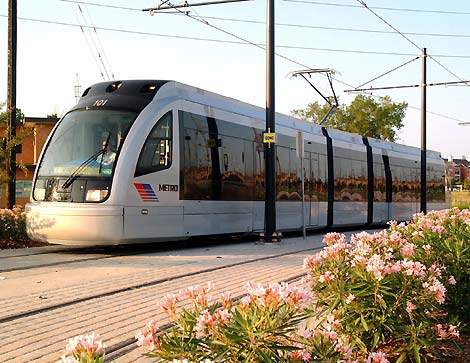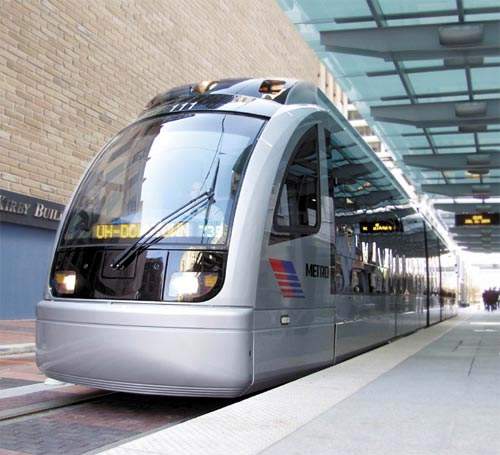At present only a single line, the MetroRail operation of the Metropolitan Transit Authority of Harris County, (trading as METRO) is poised to become a comprehensive network. By 2007, it had welcomed its 40 millionth passenger and was attaining a daily ridership of 45,000, a level that the authority had not anticipated reaching until 2020.
Harris County is better known for its principal settlement, Houston, Texas, the fourth-largest city in the US, the location of what the operators are already claiming to be (although by no means the busiest US system) the “the most successful light rail line in the country”.
The project
The Metro 2025 Plan Team identified seven travel corridors around the region that would need some form of high capacity transit in the future. The project envisaged the support and enhancement of long-term economic development and redevelopment, encouraging investors to build new shopping areas and other entertainment around the busiest stations.
The major investment study for urban transport was completed in August 1999 and Metro Board unanimously selected light rail alternative in September of the same year. Preliminary engineering on the $324m project began in January 2000 and construction started in 2001.
Delivered as a turnkey project by Siemens, the project for the Red Line opened according to schedule in January 2004. Covering also their bus and heavy rail operations, Metro’s planning for 30 miles of light rail in the area is expressed via the ‘Metro Solutions’ identity.
Infrastructure
Built with local funds, the 16-stop 1,435mm gauge line featuring street running is 7.5 miles (12km) long from Houston University (‘U-H Downtown’) via the city centre including ‘Downtown Transit Center’ to Fannin South park-and-ride terminal. To speed up construction, the project was divided into five sections with a resident engineer for each.
The line with 600/750 DC overhead supply is a two-directional rail service with stops mostly about half a mile apart. Station platforms are approximately 240ft long to accommodate the maximum dimension available between crosswalks in downtown city blocks.
From Wheeler to Commerce, the centre of the tracks is 21ft apart. Where the rail line crosses Braysand Buffalo bayous, existing road bridges were modified or rehabilitated to accommodate the tracks. The southernmost station at Fannin South was located adjacent to a new park & ride facility with approximately 1,200 parking spaces.
Nine substations were provided to supply overhead power for the LRVs. Pierce Goodwin Alexander & Linville, Houston, Texas, in charge of final architectural/engineering design, design support and construction.
PBS&J of Houston, Texas was awarded a $2.3m contract for final architectural and engineering design, design support and construction management. A detailed environmental assessment of potential impacts was conducted concurrently with preliminary engineering. The assessment ensured that the extent and definition of impacts was carefully considered in defining measures to avoid, eliminate or minimise potential impacts.
Rolling stock
Siemens supplied 18 Avanto S70 three-section articulated light rail vehicles, which provide direct access without stairs from the station to the vehicle. Built at its Sacramento plant, the bi-directional air-conditioned fleet began deliveries in 2003. The 28.9m trains are 70% low-floor and match the 350mm platform boarding height, offering maximum accessibility. Each car carries 200 passengers, with 72 seated and are able to operate in pairs at busy times.
Signalling and communications
MetroRail operations are controlled from Houston TranStar, a dedicated traffic and emergency management centre for the city and region that surrounds it. LRVs run entirely on street and share traffic signals, although they have priority at intersections. In the early stages of operation of this novel mode for the region, collisions with road vehicles ran at a high level, usually caused by drivers turning across the path of the LRVs.
MetroRail shared Metro’s existing communications infrastructure. Under the turnkey contract, Siemens was also responsible for catenary, sub-stations, signalling, the fare collection system, communications and central control. From January 2008, Metro introduced the stored-value Q Card system as part of a simplification of their fares system.
The future
In spite of the success of the Red Line and popular support among voters, in 2005 the Metro board had abandoned most of their light rail expansion plans after encountering financial and anti-rail political pressure, opting instead for the Bus Rapid Transit scheme and a heavy rail commuter line.
However, in October 2007 with changes in Federal Transit Administration assessment criteria, this was reversed, with the effect that work is due to commence on the new 10 mile (16km) east-west University light rail line, with four shorter new lines to follow.
As this now seems set to become a true network, a northern lengthening of the original line is also envisaged. Originally projected to need five years for completion, the enlarged system will call for around 100 new vehicles which are likely to be procured in one order for what is intended to be a series of openings to be complete by 2012.





